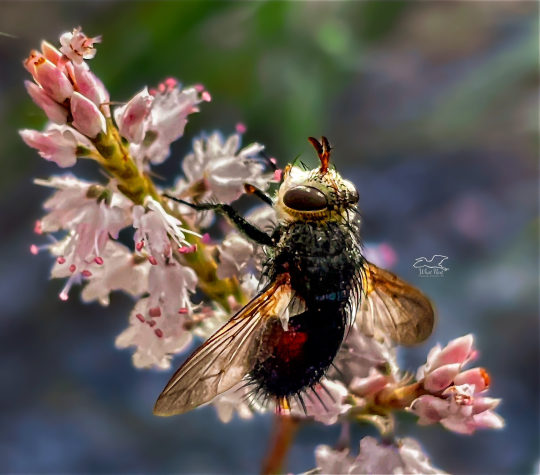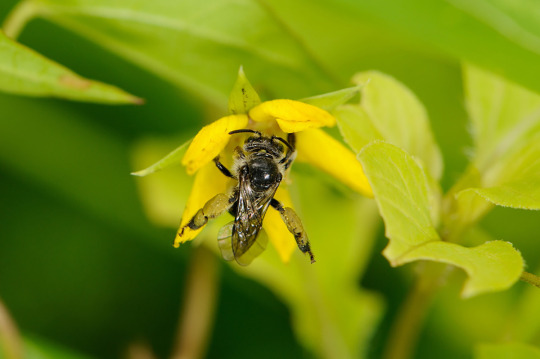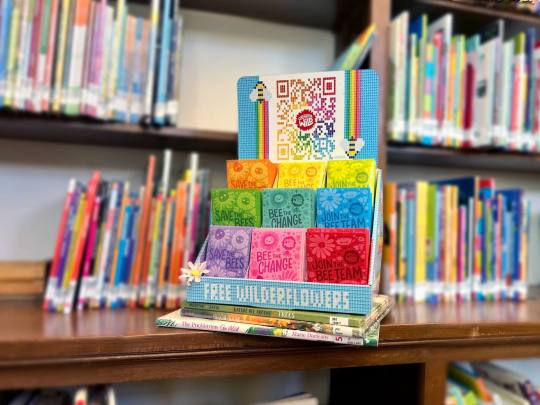#pollinator insects
Explore tagged Tumblr posts
Text
Why I grow flowers with my vegetables
I’ve written many times about the benefits of growing flowers to attract beneficial insects to the vegetable garden. They are the soldiers in the pest wars.
Grow Flowers to Attract Beneficial Insects to Your Vegetable Garden Attracting Beneficial Insects to the Vegetable Garden Pollinator Flowers for the Mild Winter Garden
I think of my garden as an insectary where a variety of pollinator and other beneficial insects can thrive. I often pause as I garden to observe them doing their jobs.
And I also grow them because I love flowers and like to make bouquets for the house and to give away.
Here are some of my favorites to grow with vegetables.
2 notes
·
View notes
Text
"A Scottish field once home to mono-crop barley has become a pollinator’s paradise after intervention from a local trust saw bumblebee numbers increase 100-fold.
Entitled Rewilding Denmarkfield, and run by the Bumblebee Conservation Trust, the project has also seen a sharp increase in the number of species passing through the rolling meadows after they were reclaimed by dozens of wildflower species.
The area north of Perth is about 90 acres in size, and surveys of bumblebees before the project began rarely recorded more than 50. But by 2023, just two years of letting “nature take the lead” that number has topped 4,000, with the number of different bee species doubling.
“This superb variety of plants attracts thousands of pollinators. Many of these plants, such as spear thistle and smooth hawk’s beard, are sometimes branded as ‘weeds’. But they are all native species that are benefiting native wildlife in different ways,” Ecologist Ellie Corsie, who has been managing the project since it began in 2021, said.
“Due to intensive arable farming, with decades of plowing, herbicide, and pesticide use, biodiversity was incredibly low when we started. Wildlife had largely been sanitized from the fields. Rewilding the site has had a remarkable benefit.”
Similar increases have been recorded in the populations of butterflies, with a tripling in the number of these insects seen on average during a ramble through the field.
The numbers of both insects are now so high that Rewilding Denmarkfield offers bee and butterfly safaris to visitors.
Local residents told the Scotsman that on spring and summer days, the field is awash with color, and hums with the sounds of bees and birds. Even as multiple housing developments expand around the Denmarkfield area, the field is a haven for wildlife."
-via Good News Network, December 2, 2024
#bees#bumblebee#save the bees#pollinators#conservation#sustainability#hope posting#insects#entomology#rewilding#scotland#europe#good news#hope
9K notes
·
View notes
Text
Bristleflies are Great Pollinators that Can be Found All Over
Bristles and Stamens Among my favorites in the insect world are the pollinators. Even though bees have probably gotten the most attention as pollinators, there are hundreds of other types of insects, birds, and even some mammals that contribute significantly to the vital process of pollination. Many of them are quite pretty (i.e. butterflies, hummingbirds, etc), but some of them aren’t really.…

View On WordPress
#bristle flies#bristle flies as pollinators#bristle fly photographs#bristly insects#flies#flies as pollinators#Florida bristle flies#Florida insects#insect photographs#insect photography#insect pollinators#insects#macro photographs#macro photography#photography#pollenators#pollinating insects#pollinator insects#pollinator photographs#pollinator photography#southern bristle flies#ugly insects
0 notes
Text

Xerces Society: Announcing The State Of The Bees Initiative: Our Plan To Study Every Wild Bee Species In The U.S.
This is really exciting news! For those unaware, the Xerces Society has been focusing on invertebrate conservation for over fifty years, and has pioneered a lot of the work to bring awareness to the devastating losses of not only insects but other terrestrial and aquatic invertebrates. It gets its name from the Xerces blue butterfly (Glaucopsyche xerces), the first North American butterfly driven to extinction by human activities.
Even if you haven't heard of the Xerces Society, you've probably come across various "Save the Bees!" campaigns. These frequently focus on the domesticated European honey bee (Apis mellifera), which, while it may be important to crop pollination in many parts of the world, is not a part of natural ecosystems in places like the Americas and Australia, and can be considered an invasive species at times. With the rise of colony collapse disorder (CCD) particularly after the turn of the 21st century, where entire domestic honeybee colonies would die off, the need to preserve bees began to gain wider public acknowledgement.
But what many people don't realize is that it is the thousands upon thousands of other native bee species worldwide that are in greater danger of extinction. They don't have armies of beekeepers giving them safe places to live and treating them for diseases and parasites. More importantly, where honey bees may visit a wide variety of plants, native bees often have a much narrower series of species they visit, and they are quite vulnerable to habitat loss. Most bees are not as social as honey bees and live solitary lives, unseen by the casual observer.
Invertebrates in general often suffer from a lack of conservation information, meaning that particularly vulnerable species may fly under the radar and risk going extinct without anyone realizing until it's too late. This ambitious program by the Xerces Society aims to solve that problem, at least for the 3,600+ species of bee in the United States. If they can assign a conservation status to each one, then that strengthens the argument toward protecting their wild habitats and working to increase their numbers. Hopefully it will also prompt more attention to other under-studied species that are in danger of going extinct simply because we don't know enough about them.
#bees#save the bees#invertebrates#arthropods#insects#entomology#nature#wildlife#animals#ecology#environment#conservation#science#scicomm#endangered species#extinction#pollinators#Xerces Society#Xerces blue
598 notes
·
View notes
Text

No I'm a bee I swear
5K notes
·
View notes
Text
society has ingrained in all of us that bugs are bad and evil and scary and they Bite You for no reason and Sting You For Fun and I would like to challenge every single person that reads this to try to step back and challenge those thoughts. CHALLENGE that knee-jerk reaction to kill every bug you see. REALIZE that killing it doesn't have to be the answer. it's fine to not want bugs in your home. but I see so many people whose FIRST choice is to kill it, even though it'd be easy to just cup it and toss it outside. why?
one of the greatest things that got me over my extremely intense arachnophobia was knowledge. learning more about the thing I was afraid of made me realize, "oh, they're just little guys trying to get by too" and I stopped killing every spider I saw.
and it's like. no, that wasp didn't sting you for fun. it stung you because it felt scared or defensive. no, the spider in your shower isn't trying to kill you. spiders need water to live too.
you don't deem a scared dog/cat evil for biting you, do you? then why are we demonizing insects and spiders for feeling scared? they are so, so small and we are so large. they don't know anything about us, they're just trying to live life. they didn't know they built their web in a bad spot. they didn't know they built their nest next to your door. please, show some kindness to these tiny creatures. I understand you can't let infestations happen or wasps build in your walls, but whenever possible, try to put bugs in a cup and take them outside. yes, even wasps. even black widows. if you want tips for safely capturing bugs, I'm always around to ask.
also, to those who say things like, "x bug eats other pest bug, so they're okay" why? why does something have to benefit you to deserve to live? shouldn't all creatures have a chance at life, even if they're ugly, even if they don't benefit you, even if they do something you don't like? what gives you the right to decide to take the life of any animal just because ahhh it looked scary? please. all I ask is you try to be kinder. it's okay to be scared, it's not okay to pointlessly kill things.
#michaelpost#bugs#insects#arthropods#something I've noticed is wasps get an EXTREME amount of hate and I'm honestly getting progressively more sick of it#and it always stems from just. untrue ideas people have about how wasps behave#and they'll throw in comments like oh they dont even pollinate like our Lovely Bees! yes they do.#and even if they didnt have any Use to you#why does that mean they dont deserve life?
1K notes
·
View notes
Text

ig - afternoondreams
#kelli soukup#nature#photography#art#nature photography#botany#botanical#bumblebee#melittology#entomology#pollinators#anthecology#pollination#cute#bugs#insects#cottagecore#floral#flora#summer#flowers#peaceful#kansas#garden#animals#meadow#prairie#film#aesthetic#detail
3K notes
·
View notes
Text

🪻🌱🐝 💜 🌿 ✨ // violets & violet miner bees // part of my natives + pollinators series // gouache on paper
tiny violet miner bees (Andrena violae) are a specific pollinator: they pollinate wood & dog violets in the Northeast, and show a strong preference for blue violets. letting your grassy yard rewild itself and grow violets every spring not only lets you make violet syrup, it also gives violet miner bees their most important food source and increases local pollinator diversity.
#my art#gouache#illustration#painting#art#cottagecore#artists on tumblr#botanical#spring#violet#pollinator#pollinators#native wildflowers#native plants#eco lawn#botanical illustration#violet miner bee#bees#cw: insects#insects
1K notes
·
View notes
Text

Plant a Bee-friendly (and butterfly friendly) garden!
See higher quality image and find out more:
PollinatorGardenBrochure.pdf (sierraclub.org)
#gardening#gardens#plants#pollinators#wildlifer#home#home and garden#conservation#environment#nature#animals#bees#butterflies#insects
485 notes
·
View notes
Text
she is beauty, she is grace; she has a gorgeous face ~
dolichovespula maculata (bald-faced hornet) that took a moment to groom herself as I was taking pictures. <3
#it goes to show that they’re really not as defensive as some people make them out to be#they’re pretty chill#after releasing her she went right back to pollinating!#dolichovespula maculata#bald faced hornet#hymenoptera#wasps#bugblr#insects#entomology
2K notes
·
View notes
Text

Bee's antenna change positions during pollen gathering. The Fairy-Land of Science. 1883.
Science History Institute
202 notes
·
View notes
Text


Our Better Nature: Put the Brakes on Honey Bees – Our Future Depends on It
Honey bees are causing grave – and in some cases irreversible – harm to the environment.
In addition to being a reliable source of honey, not to mention personal satisfaction, backyard beekeeping can be a rich learning experience for the whole family. And yet at the same time, honey bees are causing grave – and in some cases irreversible – harm to the environment. It’s imperative that beekeepers learn about the threats to native pollinators posed by honey bees and actively work to mitigate the damage as much as possible. Just to be clear, honey bees are an invasive species whose population is burgeoning. They certainly don’t need our help to survive. It’s true they’re vital to industrial-scale agriculture like California’s almond farms, which are the largest in the world, and Florida’s citrus groves. Although honey bees are relatively poor pollinators, they’re the only one that can be transported in great numbers. Outside of the vast, sterile plantations of Big Ag, honey bees don’t measurably boost pollination rates, according to a multi-year Cornell University study. Led by Dr. Scott McArt, a bee specialist at Cornell’s Dyce Lab for Honey Bee Studies, the team concluded honey bees had an insignificant effect on pollination in nearly all of New York State’s apple orchards studied. The 110 species of wild bees the researchers cataloged on apple blossoms did the real work...
Read more:
https://www.saturdayeveningpost.com/2024/05/our-better-nature-put-the-brakes-on-honey-bees-our-future-depends-on-it
226 notes
·
View notes
Text
"Next Monday [6/17/24] is the start of National Pollinator Awareness Week, and one Colorado advocacy group is hosting a flower planting drive to rewild Colorado’s meadows, gardens, and just maybe, its children too.
Created by constitutional amendment in 1992, Great Outdoors Colorado (GOCO) is a state-funded independent board that invests a portion of Colorado Lottery proceeds to help preserve and enhance the state’s parks, trails, wildlife, rivers, and open spaces.
This year, GOCO’s offshoot Generation Wild is distributing over 100,000 free packets of wildflower seeds to collection points at museums, Denver Parks and Rec. offices, and libraries all over the state to encourage kids and families to plant the seeds in their backyards.
The Save the Bees! initiative aims to make the state more beautiful, more ecologically diverse, and more friendly to pollinators.
According to a new report from the Colorado Department of Natural Resources, 20% of Colorado’s bumblebees are now at risk of extinction. Even in a small area like a backyard, planting wildflowers can make a positive impact on the local ecosystem and provide native bees with a healthy place to live.
“The Western Bumblebee population has declined in Colorado by 72%, and we’re calling on kids across Colorado to ‘bee’ the change,” said GOCO Executive Director Jackie Miller.

Named after Generation Wild’s official mascot “Wilder,” the Wilderflower Seed Mix was developed in partnership with Applewood Seed Co. and packets are now available for pickup at designated partner sites including more than 80 Little Free Library boxes.
By distributing 100,000 Wilderflower packets, Generation Wild is providing more than 56 million seeds for planting in every nook and cranny of the state. All seeds are regionally-native to Colorado, which is important for sustaining the living landscape of bees, birds, and other animals.
Additionally, by using flower species adapted to the Mile High climate, landscapers and gardeners need to use less water than if they were tending non-native plants.
“Applewood Seed Co. was excited to jump in and help Generation Wild identify a seed mix that is native to the Colorado region and the American West, containing a diversity of flower species to attract and support Colorado’s pollinator populations,” stated Norm Poppe, CEO of Applewood Seed Co. “We hope efforts like this continue to educate the public on pollinator conservation and the need to protect our native bees and butterflies.”
Concluding her statement Miller firmly stated that children grow up better outside, and if you or a parent you know agree with her, all the information on how to participate in Save the Bees! can be found here on their website, including a map showing all the local pickup points for the Wilderflower Seed Packets."
-via Good News Network, June 13, 2024
#wildflowers#wild flowers#colorado#bees#native bees#entomology#insects#save the bees#pollinators#bumblebees#bumble bee#i love bees#biodiversity#native plants#urban gardening#gardening#ecology#conservation#endangered species#wildlife conservation#enviromentalism#good news#hope#hope posting#solarpunk#denver#boulder colorado#colorado springs#libraries#public libraries
481 notes
·
View notes
Text

All that glisters is not gold. Sometimes it's just a shiny green bee, covered in pollen.
#midwest#summer#sweat bee#bee#bee photography#pollinators#pollination#wildlife photography#wildlife#wildlife photos#inscect#insect photography#nature photography#nature photos#original photography#original photographers
198 notes
·
View notes
Text
A caveat to this study: the researchers were primarily looking at insect pollinator biodiversity. Planting a few native wildflowers in your garden will not suddenly cause unusual megafauna from the surrounding hinterlands to crowd onto your porch.
That being said, this study backs up Douglas Tallamy's optimistic vision of Homegrown National Park, which calls for people in communities of all sizes to dedicate some of their yard (or porch or balcony) to native plants. This creates a patchwork of microhabitats that can support more mobile insect life and other small beings, which is particularly crucial in areas where habitat fragmentation is severe. This patchwork can create migration corridors, at least for smaller, very mobile species, between larger areas of habitat that were previously cut off from each other.
It may not seem like much to have a few pots of native flowers on your tiny little balcony compared to someone who can rewild acres of land, but it makes more of a difference than you may realize. You may just be creating a place where a pollinating insect flying by can get some nectar, or lay her eggs. Moreover, by planting native species you're showing your neighbors these plants can be just as beautiful as non-native ornamentals, and they may follow suit.
In a time when habitat loss is the single biggest cause of species endangerment and extinction, every bit of native habitat restored makes a difference.
#nature#wildlife#animals#ecology#environment#conservation#science#scicomm#pollinators#bees#butterflies#hoverflies#insects#native plants#habitat restoration#solarpunk#hopepunk#naturecore#wildflowers#good news
361 notes
·
View notes
Text

If you're having a rough day it might help you to know that bees play soccer! Happy pollinator week!
4K notes
·
View notes